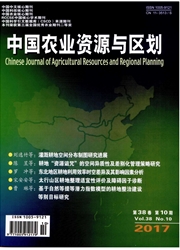

 中文摘要:
中文摘要:
农业生态系统碳汇问题已成为学者们研究的一个热点。该文首先运用李克让的Cd法估算了2000 ~2011年新疆棉花种植过程中的总碳吸收量和单位公顷碳吸收量;其次参照West To全碳分析原理,通过 汇总2000到2011年新疆棉花种植过程中农膜、农药、化肥使用、农用机械使用和灌溉过程带来的碳排放 量得出新疆棉花种植过程中的总碳排放量;再次通过计算碳吸收总量与碳排放总量的差额与棉花种植面积 的比值得到2000~2011年新疆棉花种植过程的净碳吸收量变化情况,即新疆棉花种植过程的低碳发展阻力 状况。最后提出通过加强宣传教育,引导农户正确使用农膜、农药和化肥;改造农用机械,改进节能技术; 加快节水灌溉建设3个方面的措施来降低新疆棉花种植过程中的低碳发展阻力。
 英文摘要:
英文摘要:
Carbon sink in agricultural ecosystem has become a worldwide hotspot. This paper firstly estimated the total and per hectare carbon uptake in the cotton cultivation in Xinjiang from 2000 to 2011 using Cd method of Li Kerang. Secondly, it analyzed the total carbon emissions due to the management practices, i.e., polluting plas- tics, pesticides, fertilizer, agricultural machinery and irrigation in cotton cultivation based on full carbon analysis principles. Thirdly,the net carbon uptake from 2000 to 2011 can be calculated by subtracting the total carbon up- take from total emissions per cotton planting area; Finally, it put forward 3 methods to reduce the resistance of low carbon development in cotton cultivation in Xinjiang, which included strengthening propaganda and education, guiding farmers to reasonably use polluting plastics, pesticides and chemical fertilizers, improving agricultural ma- chinery and energy saving technology, and accelerating the construction of water-saving irrigation.
 同期刊论文项目
同期刊论文项目
 同项目期刊论文
同项目期刊论文
 期刊信息
期刊信息
